Eye On Apparel: The Feel Of Fresh Fabrics
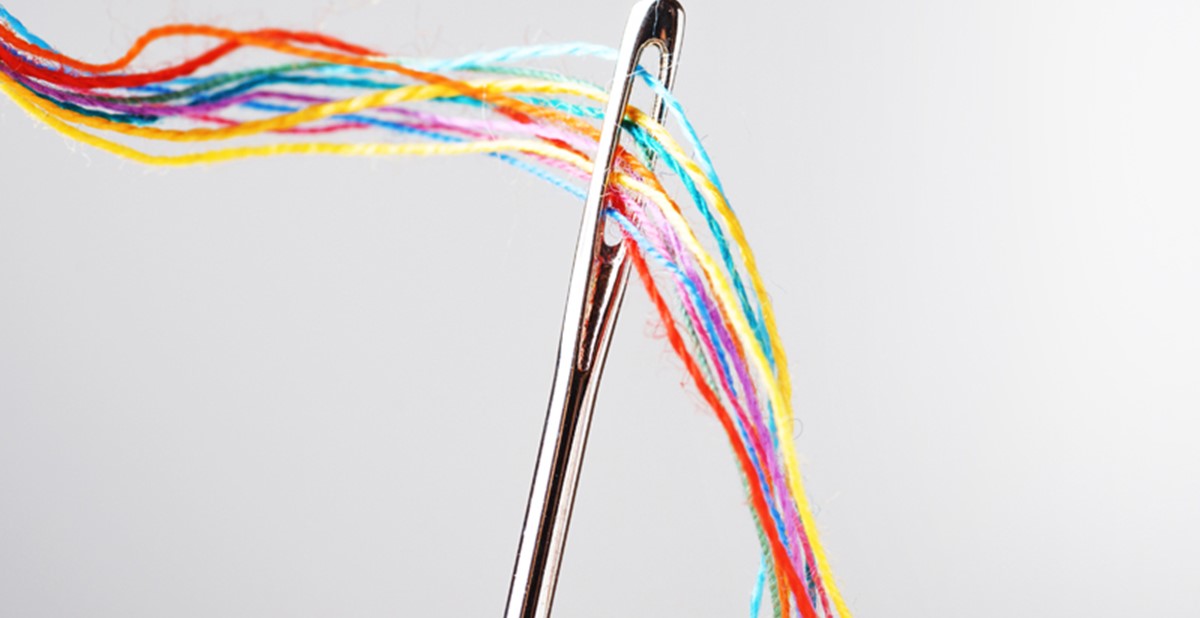
The world may “run on Dunkin’,” but it’s dressed in cotton. Known as the foundation of many fabrics and materials, from denim, velvet, corduroy, khaki and velour, to chambray, flannel and even fishnet, people worldwide have been wearing cotton for some 7,000 years, and it remains one of the most popular, non-synthetic fabrics used today. Many of us can likely recall the Cotton, Inc. commercials with the catchy phrase, “The fabric of our lives.” As per Jonathan Robins, author of Cotton and Race Across the Atlantic, “We live in a world shaped by cotton.”
But, despite our love for cotton—it’s no longer the only fabric favored by manufacturers or preferred by customers. There is a range of fabrics available, which carry their own unique benefits, from moisture-wicking qualities, to eco-friendly practices, sustainability and reduction of harmful emissions and waste. Here’s a look at some of the main types of alternative fabrics.
–––––––––––––––––––––––––––––––––––––––––––––––––––––––––––––––––––

Fabric made using bio-synthetic yarn is produced from organic sources, like bamboo, banana tree leaves, chitin (crab and shrimp shells), corn husk fibers, cupro (cotton plant lintels), milk, seaweed, soy rayon, Tencel and viscose (wood cellulose). The yarn is made by cooking cellulose or polymers into a semiliquid mixture, then pumping the mixture through the small holes of a spinneret, which produces fiber threads that can be woven into yarn. These yarns are often moth-proof, may be hypoallergenic, are machine-washable and can imitate the properties of other fibers, like silk and wool, though the fibers can be itchy, have little elasticity and retain less heat.
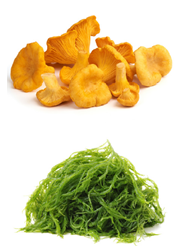

Some of the natural sources may prove rather unusual and less common, with fibers extracted from mushrooms and seaweed (both pictured at right), wood, soybeans and coconut fibers, and fish leather as a leather substitute. MycoWorks, a San Francisco-based startup that produces sustainable goods and apparel from fungi, creates leather substitutes using mushrooms; Ananas Anam, a manufacturer in the UK, makes Piñatex, a natural textile made from pineapple leaf fibers.
Then, there’s hagfish slime and spoiled milk. Scientists found that when a hagfish—an eel-shaped fish—responds to predators, it releases a slimy substance containing twisted protein fibers housed in mucus. The mucus absorbs water, which causes the protein fibers to expand, creating a dense mixture of slime and water that can grow to 10,000 times its original size. Each individual fiber can expand up to 30 centimeters in length, and produces a strong, silk-like hand. In the case of milk, an individual t-shirt can be made using less than a half-gallon of spoiled milk—which would have been discarded anyway—and produces an incredibly soft feel. (No, it doesn’t smell like rotten milk.)
–––––––––––––––––––––––––––––––––––––––––––––––––––––––––


In The Colorado King, author Stephen King writes, “Sooner or later, everything old is new again,” and so it goes with recycled fabric. Manufacturers can give new life—and new love—to tattered and discarded clothing while offering an eco-friendly solution to the million tons of textile waste generated annually by American factories.
Two of the most commonly recycled fabrics are nylon and polyester. Nylon fibers (pictured at right) are made from petroleum, and most recycled nylon is derived from recycled plastic bottles, though even when recycled and converted into a fabric, it remains non-biodegradable and can take between 20 and 200 years to decompose in a landfill.
Similar in scope to recycled polyester, REPREVE—a material created by the eponymous company that manufactures products sold by Patagonia, Ford and The North Face—makes clothing using recycled plastic bottles. In this process, the bottles are collected and chopped, then ground, melted and reformed into REPREVE chips, melted again and made into a REPREVE recycled fiber that is 100 percent recycled plastic. The fiber is then used to make clothing. Between 2007 and 2015, REPREVE recycled more than two billion plastic bottles.
–––––––––––––––––––––––––––––––––––––––––––––––––––––––––––––––––––

And of course, there are those alternative fabrics that are so sought after, they have become mainstream in both retail and in promotional products. Here’s a few examples:


Perhaps made ever-more popular by the decriminalization of marijuana in several U.S. states, hemp is one of the most abundant and practical alternative clothing materials. Hemp fabrics are made from cannabis sativa fiber or industrial hemp, and hemp plants are incredibly fast-growing with a high return. According to Interesting Engineering, hemp plants produce 250 percent more fiber than cotton, within the same amount of land space. Hemp also carries antibacterial properties, and is known to fight the growth and spread of bacteria.
–––––––––––––––––––––––––––––––––––––––––––––––––––––––––
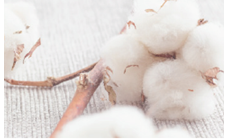

Yes, one of the greatest alternatives to cotton is—cotton—but with an organic twist. Organic cotton is grown without pesticides, fertilizers, insecticides, herbicides or genetically-modified organisms, making it more eco-friendly than traditional cotton. Organic cotton also produces nearly half as much carbon dioxide as traditional cotton and requires less water to grow. And hey, it’s cotton, so we know it’s super soft to the touch.
–––––––––––––––––––––––––––––––––––––––––––––––––––––––––
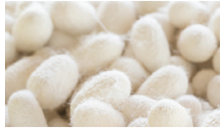

Also known as ahimsa silk, peace silk is an option that’s considered vegan, as it is made using the cocoon of a silkworm after the fully-grown moth has discarded it. The origin of peace silk is rooted in non-violence to other forms of life, and, as such, no worms or moths are harmed in the process. The material is 100 percent eco-friendly, and peace silk is harvested naturally, rather than farmed.
–––––––––––––––––––––––––––––––––––––––––––––––––––––––––––––––––––

A new spin on the heathered, mesh golf tee, the Greg Norman Play Dry Heather Solid Polo combines superfine microfiber yarn with spandex for added stretch and comfort. The shirt is made using a combination of 90 percent polyester and 10 percent spandex, with Play Dry moisture management—which transports moisture to the outer layer of the garment to evaporate—UPF 50+, back yoke and a shark embroidered on the wearer's left hem. Available in men's and women's S-3XL in Atlantic blue heather, black heather, blue mist heather and navy heather (shown).
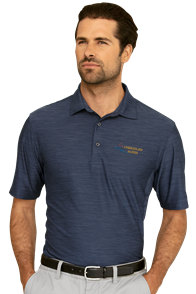
Vantage Apparel / PPAI 113235 / www.vantageapparel.com
–––––––––––––––––––––––––––––––––––––––––––––––––––––––––
Bold and brilliant, in colors vibrant enough to put a smile on the wearer’s face, the 100A Unisex Ultimate Short-Sleeve Tee is made with polyester fibers from recyclables, like plastic bottles. Leaving a smaller carbon footprint, REPREVE- recycled polyester consumes less petroleum, emits fewer greenhouse gases and conserves more water and energy. Available in a myriad of colors, the cotton is dyed using ColorZen technology, which requires 90 percent less water, 75 percent less energy and 95 percent fewer chemicals. Available in XS-4XL in solid colors and heather grey, and XS-3XL in heathers, in 24 colors, shown in, from left, Pacific blue, royal, bright yellow, bright orange and red.
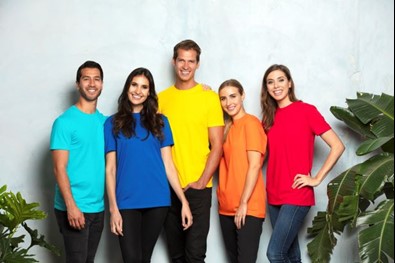
Threadfast Apparel / PPAI 622344 / www.threadfastapparel.com
–––––––––––––––––––––––––––––––––––––––––––––––––––––––––
For a sleek look, time and time again, the Sandhill Dress Shirt is a top choice for workwear, with a 95 percent polyester and five percent spandex blend that’s not only breathable, but stretchable and trendy. Featuring moisture-wicking comfort for all-day wear, the woven shirt features a subtle mini-check pattern and spread color, with decoration options including embroidery, heat transfer and die mold transfer. Available in men’s S-5XL and women’s S-3XL in grey/white, light blue/white and blue/white (shown).
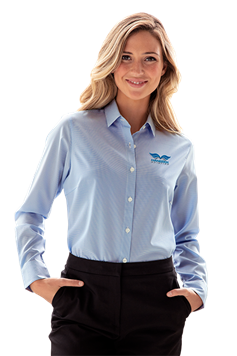
Vantage Apparel / PPAI 113235 / www.vantageapparel.com
–––––––––––––––––––––––––––––––––––––––––––––––––––––––––
A jacket that’s fit for rain or shine, a light breeze or strong wind, the Luxe Interlock Jacket is extremely lightweight, with a smooth texture. Made from a combination of 80 percent polyester, 16 percent viscose and four percent spandex, the fabric is soft, compact and wrinkle-free, with a full-zip front that includes hand pockets, spandex-binding accents and a cover-stitching detail. Available in men’s S-4XL in colors navy, black and dark heather grey (shown), and women’s XS-3XL in colors plum, black and dark heather grey.
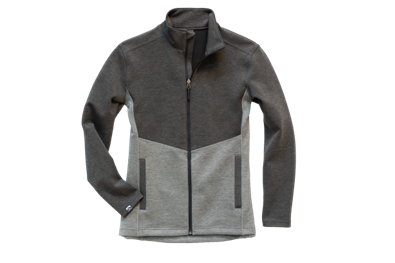
Storm Creek / PPAI 438091 / www.stormcreek.com
–––––––––––––––––––––––––––––––––––––––––––––––––––––––––
Made with a combination of cotton and rich, blended yarns, the unisex Peppered Fleece 1/4 Zip is fit for year-round comfort and style, while adding a touch of on-trend streetwear to your brand. Made from a combination of 55 percent cotton and 45 percent polyester, details include yarn-dyed stripes inside the collar, cuffs and waist, which includes a pouch pocket. Available in sizes S-3XL in nine colors and four coordinating styles, shown in pepper-maroon.
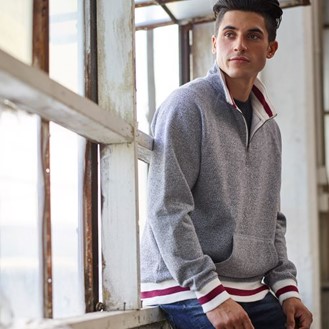
J America Blanks / PPAI 351699 / www.jamericablanks.com
–––––––––––––––––––––––––––––––––––––––––––––––––––––––––
The perfect foundation for sharing critical brand messaging or a colorful, attention-grabbing logo, the Mega Cap PET Recycled is a structured cap made from 50 percent cotton and 50 percent recycled polyester—which is made by melting discarded plastics, like water bottles, and re-spinning it into new polyester fiber. Details include a mid-profile and six-panel construction with a pre-curved visor and a convenient hook-and-loop closure. Available in red, navy, black, gray, khaki and white (shown).
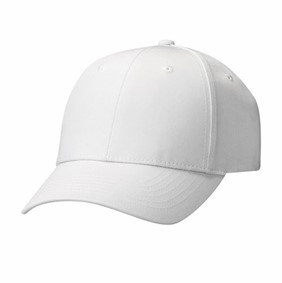
Kati Sportcap & Bag / PPAI 113758 / www.katisportcap.com
–––––––––––––––––––––––––––––––––––––––––––––––––––––––––
A versatile, lightweight accessory fit for fashion, comfort and everything in between, the oversized Eco Seed Stitch Scarf is made from 75 percent recycled cotton and 25 percent polyester, which is also mostly recycled. Made in the USA and available in five attractive colors—smoke, Bordeaux, black, vapor and moss (shown)—the material is sourced from scrap fabric from leftover projects. It’s sized generously at 25 x 76 inches.
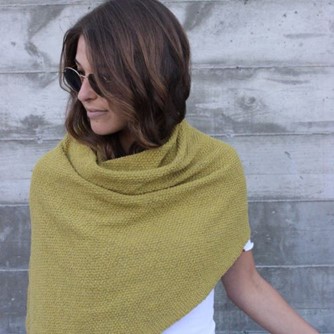
In2Green / PPAI 748975 / www.in2green.com
–––––––––––––––––––––––––––––––––––––––––––––––––––––––––
Perfect for pairing with jeans and a tee for a casual look, or with slacks and a blouse for a work-appropriate ensemble, the Eco Petite Houndstooth Poncho is the perfect choice for a high-quality corporate gift that also bears an eco-friendly element—it’s made from 50 percent recycled cotton and 50 percent polyester, which is mostly recycled, using leftover fabric scraps. Made in the USA, the poncho can be worn in a number of ways—from a high-low pullover to a thick scarf—and is available in smoke/milk, flax-navy and black/oatmeal (shown). 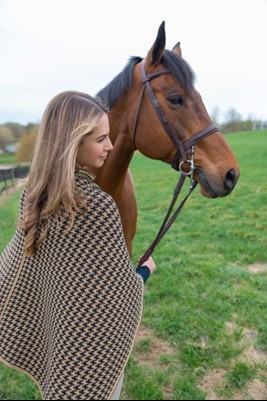
In2Green / PPAI 748975 / www.in2green.com
–––––––––––––––––––––––––––––––––––––––––––––––––––––––––
For high-quality tees that’ll yield unending brand exposure, the Go-To Collection includes 12 fashion basics—including t-shirts, v-necks and muscle tees—that leave a lasting impact. The tees are made using sustainable practices, which incorporate low-impact dyes, and both recycled and organic materials, leading to an annual conservation of 860,000 gallons of water and recycling 1.8 million plastic bottles. Available in 30 colors—shown in white and maize—in men’s XS-3XL and women’s XS-XL.
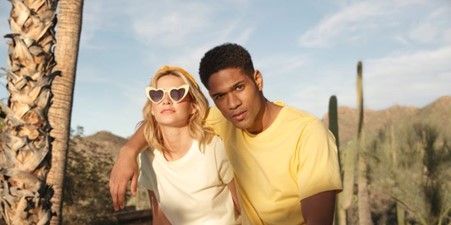
Hanes/Champion / PPAI 191138 / www.hanes.com
–––––––––––––––––––––––––––––––––––––––––––––––––––––––––––––––––––
Danielle Renda is associate editor of PPB.

